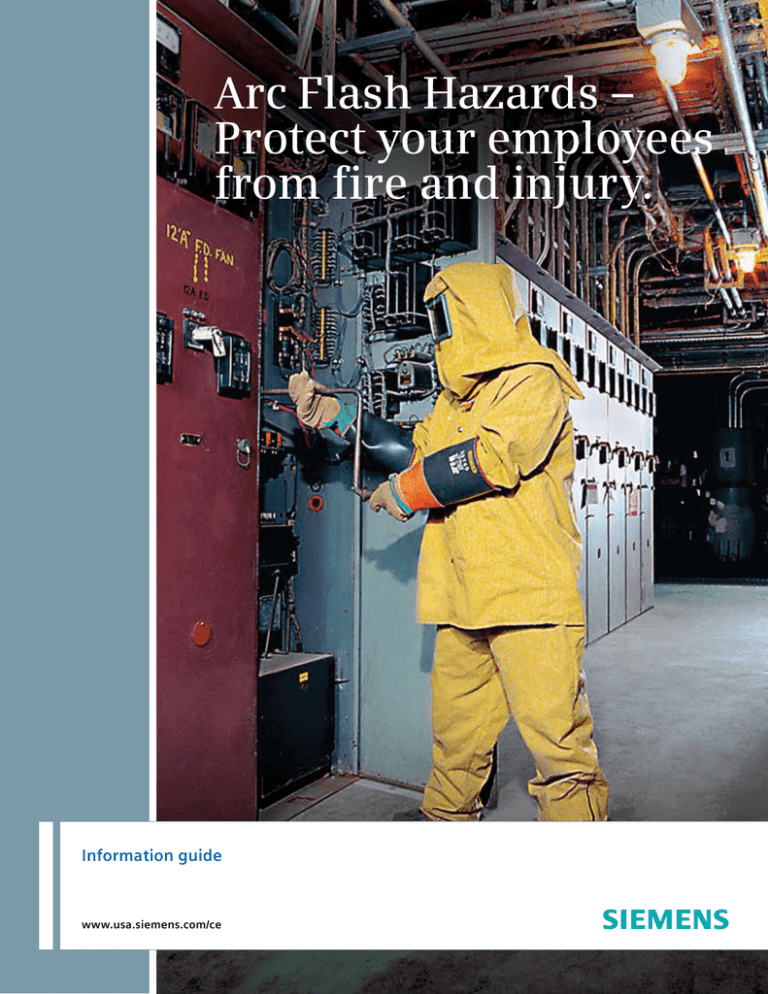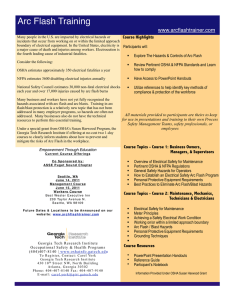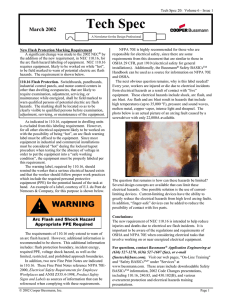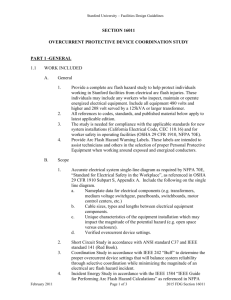
Arc Flash Hazards –
Protect your employees
from fire and injury.
Information guide
www.usa.siemens.com/ce
What causes an arc flash? Are you familiar with the changing
codes and government regulations? What can you do to protect
your employees from fire and injury? This paper is designed to
address those concerns and answer questions to help protect your
assets.
What is an arc flash?
An arc flash is a current flowing through air that flashes from one
exposed live conductor to another conductor or to ground. When
an arc flash happens, the temperatures can reach up to 35,000
degrees Fahrenheit. This is four times the temperature on the
surface of the sun.
The result can be destruction of equipment, fire, and injury.
What steps can help protect employees from arc flash?
1. Work de-energized.
2. Have a professional engineer calculate the short circuits.
3. Perform a Protective Device Coordination Study.
4. Perform an arc flash calculation.
5. Document the findings.
6. Determine specifics of unsafe work locations.
7. Eliminate hazards through system changes or operational
procedures.
8. Apply hazard labels describing required PPE and boundaries for
equipment use.
9. Establish safe work practice procedures.
Are the generic PPE recommendations of the National Fire
Protection Association (NFPA) 70E sufficient?
What causes an arc flash?
An arc flash occurs when electrical clearances are reduced or
compromised by deteriorating insulation or human error. The
arc flash follows a conductive path between two hot (energized)
wires or between a hot wire and ground.
How can I protect employees from arc flashes?
Following NFPA 70E guidelines is highly recommended, however,
the actual field conditions can be more hazardous than the NFPA
70E guidelines. An arc flash study can reveal equipment with
elevated hazard levels. This will help you protect your employees.
The General Duty Clause and the Occupational Safety &
Health Administration (OSHA)
The recommended way to protect employees is to de-energize
equipment prior to working on it. When de-energization is not
feasible per code, enforce safe work practices. Require your
employees to be properly suited in conjunction with a recent
arc flash study. Actions that require PPE include, but are not
limited to, operating a breaker with the deadfront cover removed,
voltage testing, working on energized equipment, and racking in
or out drawout units.
The General Duty Clause states “each employer shall furnish . . .
a place of employment . . . free from recognized hazards that are
causing or are likely to cause death or serious physical harm to his
employees . . . ” The clause does not provide enough detail to
determine the proper level of PPE required.
Why is an arc flash study important?
•
•
•
•
Without an arc flash study you will not know the actual level of
danger or the appropriate personal protective equipment (PPE)
required for employees. Electrical systems are dynamic and
change over time. Internal changes, such as adding new
equipment can affect the level of arc flash energy. A study must
be updated every time the system changes. External changes,
such as a utility changing transformers or changes at your utility’s
closest substation can severely impact your level of arc flash
energy. Performing this study will help you create a safer work
environment.
OSHA has referenced the “General Duty Clause” when citing
employers for:
Failing to keep the jobsite free from hazards.
Hazards that are likely to cause serious harm or death.
Recognizing the hazard, but not taking corrective action.
Failing to take advantage of “feasible and useful methods” to
protect against the hazard.
Proper PPE is cited as a “feasible and useful method” for
addressing hazards while using a piece of equipment. The only
way to provide this level of detail is to perform the arc flash study.
Explanation of the 2008 National Electrical Code®
(NEC®) Section 110.16
“Electrical equipment such as switchboards, panelboards,
industrial control panels, meter socket enclosures, and motor
control centers that are in other than dwelling occupancies and
are likely to require examination, adjustment, servicing, or
maintenance while energized shall be field marked to warn
qualified persons of potential electric arc flash hazards. The
marking shall be located so as to be clearly visible to qualified
persons before examination, adjustment, servicing, or
maintenance of the equipment.”
FPN No. 1: NFPA 70E-2000. Electrical Safety Requirements for Employee
Workplaces, provides assistance in determining severity of potential
exposure, planning safe work practices, and selecting personal protective
equipment (PPE).
FPN No. 2: ANSI® Z535.4-1998, Product Safety Signs and Labels, provides
guidelines for the design of safety signs and labels for application to
products.
Understanding the NEC
“. . . other than dwelling occupancies . . .” What is
considered a dwelling?
Per the NEC, a dwelling is a single unit, providing complete and
independent living facilities for one or more persons. This
includes permanent provisions for living, sleeping, cooking, and
sanitation. If the building is a dwelling, it does not require arc
flash labeling. Office buildings, plants, stadiums, malls, and
schools are not considered dwelling occupancies, therefore are
covered by the NEC provision requiring an arc flash warning.
“. . . are likely to require examination, adjustment, servicing,
or maintenance while energized . . .” Will these happen in my
facility?
Quite possibly. NFPA 70E states that equipment can be worked
hot during “infeasible conditions” which include start-up testing,
troubleshooting and diagnostics or a continuous process
segment. If electricians are starting up your facility, doing
troubleshooting, or if your facility is a continuous process, then
they need to be protected.
Whenever possible, it is recommended that work is completed
when equipment is de-energized.
“. . . shall be field marked . . .” What does this mean?
This is a field marking rather than a factory marking since it is
application oriented.
“. . . to warn qualified persons of potential electric arc flash
hazards . . .” Who is a qualified person?
Per the NEC, a qualified person is one who has skills and
knowledge related to the construction and operation of the
electrical equipment and installations and has received safety
training to recognize and avoid the hazards involved. Refer to
NFPA 70E-2004, Standard for Electrical Safety in the Workplace,
for electrical safety training requirements.”
Will a generic label suffice?
While the generic label like the one below, left, will meet the NEC
requirements to field mark and warn, it will not address actual
site conditions, safe work boundaries, or PPE. The label
on the right is from a study and provides the additional useful
information on clothing and safe work boundaries.
What is OSHA’s Stance on Personal Protective
Equipment (PPE)?
In most cases, OSHA requires employers to furnish PPE.
http://www.osha.gov/pls/oshaweb/owadisp.show_document?p_
table=NEWS_RELEASES&p_id=14739
In November 2007, OSHA announced the employer-paid personal
protective equipment final rule.
WASHINGTON – The U.S. Department of Labor’s Occupational
Safety and Health Administration (OSHA) [November 14, 2007]
announced a final rule on employer-paid personal protective
equipment (PPE). Under the rule, all PPE, with a few exceptions,
will be provided at no cost to the employee. OSHA anticipates
that this rule will have substantial safety benefits that will result
in more than 21,000 fewer occupational injuries per year.
The rule will be published in the Federal Register on
November 15, 2007.
“Employees exposed to safety and health hazards may need to
wear personal protective equipment to be protected from injury,
illness, and death caused by exposure to those hazards,” said
Assistant Secretary of Labor for OSHA Edwin G. Foulke Jr. “This
final rule will clarify who is responsible for paying for PPE, which
OSHA anticipates will lead to greater compliance and potential
avoidance of thousands of workplace injuries each year.”
The final rule contains a few exceptions for ordinary safety-toed
footwear, ordinary prescription safety eyewear, logging boots,
ordinary clothing, and weather-related gear. The final rule also
clarifies OSHA’s requirements regarding payment for employeeowned PPE and replacement PPE. While these clarifications have
added several paragraphs to the regulatory text, the final rule
provides employees no less protection than they would have
received under the 1999 proposed standard. The rule also
provides an enforcement deadline of six months from the date of
publication [May 15, 2008] to allow employers time to change
their existing PPE payment policies to accommodate the final rule.
How many people are hurt by Arc Flash?
Capelli-Schellpfeffer, Inc. of Chicago, a national tracking
service, reports 5 to 10 arc flash injuries a day that require
hospitalization. However, there are additional arc flash incidents
that are not documented for national tracking. Regardless,
5 to 10 per day equates to 1,800 to 3,600 injuries per year
nationwide.
The 2009 Edition of NFPA 70E will require equipment to be field
marked with the available incident energy or the required level of
PPE.
Conclusion
Arc flashes can maim or kill. Having Siemens perform an arc flash
study is a feasible and useful first step for protection. The study
will determine the appropriate PPE at that time. If an arc-flash
hazard is present, or likely to be present, then you, the employer,
must select, purchase, and require employees to use the
protective apparel. Employers who conduct the hazard/risk
assessment, and select, purchase, and require their employees to
use protective clothing and other PPE appropriate for the task, as
stated in the NFPA 70E standard, 2000 Edition, are deemed in
compliance with the Hazard Assessment and Equipment Selection
OSHA standard.
NFPA, NEC and National Electric Code are registered trademarks of the
National Fire Protection Association.
ANSI is a registered trademark of the American National Standards
Institute.
Under the Occupational Safety and Health Act of 1970, employers
are responsible for providing safe and healthful workplaces for
their employees. OSHA’s role is to assure the safety and health of
America’s working men and women by setting and enforcing
standards; providing training, outreach and education;
establishing partnerships; and encouraging continual process
improvement in workplace safety and health. For more
information, visit www.osha.gov.
Siemens Industry, Inc.
Building Technologies Division
5400 Triangle Parkway
Norcross, GA 30092
1-800-964-4114
Subject to change without prior notice
Order No.: PDBR-ARCFH-1009
All rights reserved
Printed in USA
The information provided in this brochure contains merely
general descriptions or characteristics of performance
which in case of actual use do not always apply as described
or which may change as a result of further development
of the products. An obligation to provide the respective
characteristics shall only exist if expressly agreed in the
terms of contract.
©2009 Siemens Industry, Inc.
info.us@siemens.com
www.usa.siemens.com/ce
All product designations may be trademarks or product
names of Siemens AG or supplier companies whose use by
third parties for their own purposes could violate the rights
of the owners.






